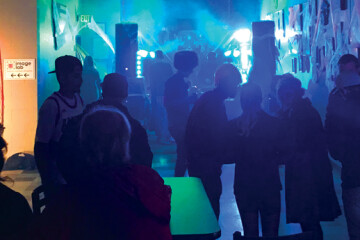Controversial "Black-Olive" City Commission Decision is October 9th
On Monday, October 9th, the City Commission will determine the fate of the controversial, precedent-setting Black Olive development application for a five-story downtown apartment building abutting historic south Bozeman. The project application has been submitted by the developer HomeBase Montana.
The Commission’s review of the application comes on the heels of its recent decision to re-affirm and re-adopt commercial design rules revised in 2015 without public input by a taskforce of developers and architects with a vested interest in seeing the rules changed. The original rules, part of the city’s Neighborhood Conservation Overlay District Plan, had been developed through a comprehensive process with extensive public involvement. The revisions opened the door for large-scale, high rise development adjacent to existing residential neighborhoods and historic areas with little consideration of appropriate transitions or neighborhood compatibility.
Over the past year, hundreds of citizens from all over Bozeman have been working to stop the Black Olive project; they see approval of this project as a tipping point that will open the door to many similar projects. The organization founded by these citizens, Save Bozeman, believes that development in and around downtown Bozeman should be guided by proactive planning that places limits on development in terms of height, character, and transitioning in places where B3-zoned commercial properties are being built adjacent to one- and two-story residences, buildings, and historic areas. As stated on its website (www.SaveBozeman.com), the organization supports contextually appropriate and manageable growth in and around Bozeman neighborhoods. Its members are for “infill not overfill.” Specifically, the concerned citizens and business owners of Save Bozeman object to the design precedent created by the Black Olive project, which features south-facing balconies overlooking existing neighbors, dark and out-of-context design, unaffordable units, and no on-site parking. Bozeman’s citizen-led Design Review Board and Historic Preservation Advisory Board have overwhelmingly objected to the project, stating that it is the wrong type of building in the wrong location.
On Monday, October 9, after rejecting the controversial Black Olive application twice in the past year, the City Commission will consider approval of a third application that fails to respond substantially to neighborhood and community concerns.
A major point of contention for the Black Olive proposal is the parking impact on downtown Bozeman and nearby residential neighborhoods already struggling with clogged street parking. Many residents are already unable to park near their own homes. Save Bozeman contends that large-scale, high-rise residential projects (like the six-story 5 West Building and the five-story Black Olive building) will greatly reduce parking near downtown for special events like the Bite of Bozeman, parades, Sweet Pea Festival, Art Walk, Music on Main and the Bogert Farmers’ Market, threatening their future viability. In addition, Save Bozeman is concerned about the ability of the general public -- regardless of age, socioeconomic status, or part of town they reside in – to park in or near downtown for shopping, dining, and entertainment.
The capacity for public parking in the downtown parking garage, which was built with public funds, might also be compromised. Currently, a significant number of spots in the garage are leased to the 5 West condos (costing $500,000 and up) and Element Hotel for their residents and patrons. Both the latter projects were created by HomeBase Montana, the same out-of-state developer proposing the Black Olive building. HomeBase has purchased and plans to develop multiple properties after Black Olive, including a large project being considered for the parking lot north of the Montana Conservation Corp and west of the old hospital.
A major parking study conducted by Save Bozeman shows that Black Olive and other large-scale projects immediately adjacent to neighborhoods will substantially exacerbate current parking problems. Developers and some city planners compare Bozeman to Portland, Oregon and Austin, Texas, contending that residents of the Black Olive building won’t have vehicles and will walk everywhere. Save Bozeman argues that these residents might walk sometimes but will likely still have cars and recreation vehicles (owned by themselves and their guests), which will all further clog neighborhood streets. Further, Portland and Austin, unlike Bozeman, do not have Montana winters to contend with and have significant public transportation options. .
Save Bozeman believes that the seamless historic character of downtown Bozeman and its surrounding neighborhoods will be lost if a high-rise wall of buildings is allowed to separate the two areas. If Black Olive is approved, the group believes, it will set the stage for a wall of large-scale buildings ringing the downtown area.
Exhaustive research by Save Bozeman reveals how the current controversy developed.
In 2015, the Downtown Bozeman Partnership (DBP) approached City staff about a desire to allow development of high rise projects on commercial properties in downtown B3 commercial zones within the Neighborhood Conservation Overlay District (NCOD). Such large scale projects, at the time, were not possible due to neighborhood and historic area protections within the NCOD. In response, City planning staff (working with the DBP) formed a taskforce to investigate possible revisions, with taskforce members including DBP staff, architects, and developers solicited to serve by private invitation. No neighborhood representatives were involved. The taskforce developed modified temporary guidelines and submitted them to the City Commission for approval, citing the proposed SoBo project (on Babcock south of the Molly Brown) and the Black Olive project as examples of potential projects that could move forward if the design rules were changed. The Commission approved the temporary changes, removing obstacles to SoBo (its architect was a member of the taskforce) and Black Olive. HomeBase Montana shortly thereafter purchased the Black Olive property to go ahead with its development.
The above-described process violated state constitutional law. Before approving the rule changes, the Commission was required to give the general public 15 days’ notice of the potential changes, and to give written notice to affected residential property owner within 150 feet of any B3 property within the NCOD. Residential property owners did not receive the latter notice, and notice to the general public occurred only 5 days and 1 day prior to the Commission’s vote (by means of a small public notice in the Bozeman Chronicle).
The above are undisputed facts in Save Bozeman’s recent request for an injunction to keep the temporary revised rules from being used to approve the permanent development of Black Olive. For more information on these facts, visit www.savebozeman.org/2015-rule-change.
Having not been properly notified by the City Commission, Bozeman citizens learned of the temporary commercial design rule change only when City staff kept referring to the commercial design rules (Subchapter 4B of the NCOD) as the basis for possible approval of the Black Olive development. Save Bozeman was formed at that time and immediately went to work investigating the rule-change process. On multiple occasions, the group asked the City Commission to place a moratorium on the permanent approval of any projects, including Black Olive, relying on the 2015 temporary rule change. These requests were denied.
Finally, in August, 2017, Save Bozeman filed for an injunction to prevent large scale projects (like Black Olive) from being reviewed by the City using the adopted rule revisions as the basis for decision. The injunction was denied, not on its merits, but because the statute of limitations had run out. The statute of limitations was determined to have started on the day the temporary rules were adopted, even though the public was not made aware of the action at that time. Shortly after the ruling on the Save Bozeman injunction, the City Commission voted to re-affirm and re-adopt the temporary rules changes, again, without the legally-required written notice of affected property owners. A large crowd of residents spoke against the rule changes; no one spoke in favor. But public input was ignored.
On October 9, 2017, at 6 p.m., the City Commission will vote to accept or reject HomeBase Montana’s third application for the large-scale Black Olive development. The Commission could potentially cite the recently re-adopted rule change as the basis of a decision to approve the Black Olive application. This meeting is a critical opportunity for Bozeman residents to stop the Black Olive development and other over-the-top, unreasonable projects like it. The City Commission needs to know that the public disapproves of the project and the precedent it sets. If approved, Black Olive will set the stage for a towering wall of high rises around Downtown Bozeman, built with little or no consideration of adjacent neighborhoods and historic areas. Neighborhood privacy and character, as well as convenient neighborhood parking will be things of the past.
The City Commission has the power to reject the Black Olive project based on overwhelming citizen objection and input. If citizens show up and speak out, it is the hope of Save Bozeman that the Commission will at last listen to the constituents it represents.
If you care about Bozeman’s future, Bozeman neighborhoods and historic character, please attend and make public comment at the October 9th Bozeman City Commission meeting at 6 PM and also send written comment to the City Commissioners at Agenda@Bozeman.net. It’s essential that you mention the Black-Olive project specifically. Letters to the editor in the Bozeman Chronicle are also encouraged via email to citydesk@dailychronicle.com To contact Save Bozeman directly, email Info@SaveBozeman.org. Visit our Facebook page at www.Facebook.com/SaveBozeman


